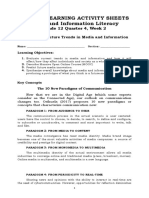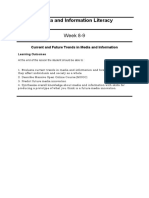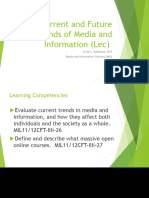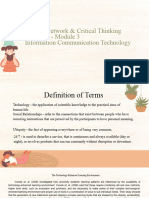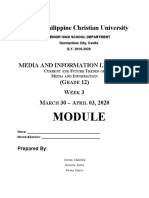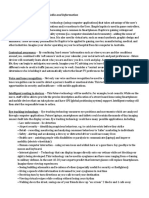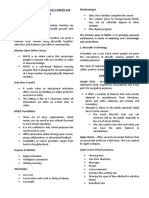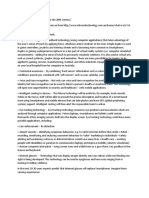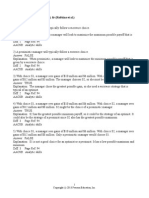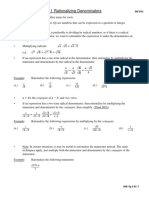Republic of the Philippines
Bangsamoro Autonomous Region in Muslim Mindanao
Ministry of Basic Higher and Technical Education
Tawi-Tawi School of Fisheries
Senior High School
S.Y. 2022-2023
MEDIA AND INFORMATION LITERACY
SECOND QUARTER
Lesson
The Power of Media and
1 Information
Citizen Journalism and Empowerment
• Citizen journalism is the gathering and reporting of news by non-professional journalists.
• It involves citizens actively collecting, reporting, analyzing, and disseminating news and information for
democracy and development.
• It is an alternative and activist form of news gathering and reporting that functions outside mainstream media
institutions.
• It is when people, or the audience, use the press tools they have in their possession to inform one another.
Online Selling Phenomenon
• The pandemic has led to the flourishing of online platforms like Lazada, Shopee, Grab Food, Food Panda, and
FaceBook Live.
• These platforms have become virtual malls for easy access to products without leaving their homes.
• Small scale enterprises have flourished through online selling via Facebook Live and deliveries through
“pasabuy.”
Transitioning from Traditional Shopping Methods to Online
• The pandemic has led many businesses to transition to online to cater to their customers.
• Proper research and development are needed to ensure the quality of products in the new normal.
• The quarantine has challenged e-commerce platforms, restaurants, and other online sellers to develop their
services as it will reflect on customers.
• The new normal has urged online sellers, e-commerce platforms, and restaurants to refine collaboration methods
with its partner channels to ensure quality service.
• The potential of people reaching success through online selling is vast, with new millionaire sellers every time a
campaign is run.
7
� Lesson Current and Future
Trends in Media and
2
Information
The Digital Age and New Paradigms of Communication
• The digital age has transformed traditional models of communication, introducing 10 new
paradigms.
• Paradigm 1: From Audience to User: User-centered communication processes with control over
choices, decisions, and interactions.
• Paradigm 2: From Media to Content: Media brand image becomes a valuable source of credibility
and prestige for digital content.
• Paradigm 3: From Multimedia to Multimedia: The convergence of online and traditional media,
forming a new language.
• Paradigm 4: From Periodicity to Real-Time: Real-time interaction promotes dynamism and new
conversational styles.
• Paradigm 5: From Scratch to abundance: User's time is the new scarce resource for managing
data, news, and opinions.
• Paradigm 6: From Editor-Mediated to Non-Mediated: Worldwide publishing without editors, with a
close peer review process, and open to reader comments.
• Paradigm 7: From Distribution to Access: Access means seeking, searching, navigating, surfing,
and deciding, contrary to passive reception of media content.
• Paradigm 8: From One Way to Interactiveity: User can choose the format of information display,
produce input for a system, and communicate with other system users.
• Paradigm 9: From Linear to Hypertext: Hypertext becomes the grammar of the digital world, with
pathways built on links.
• Paradigm 10: From Data to Knowledge: Media's strategic mission is the information about the
information, combining information intelligence, interpretation, filtering, and searching with
interactive multimedia narratives.
Keep in mind these ten paradigms as we go over this lesson as well as the succeeding ones.
Trends in Digital Technology
Many of the technological advances we are seeing today will shape our daily lives in the future – the way we relax,
interact, communicate and conduct business. From virtual worlds, avatar emotions, artificial intelligence,
computer generated storytelling and narrative, interactive 360 holographic images, mixed reality, stress disorder
virtual therapies and so much more. ICT will continue to advance, empower and transform every aspect of our life.
Here are some of these emerging technologies and trends.
Haptics technology
Is a feedback technology (using computer
applications) that takes advantage of the user’s
sense of touch by applying force, vibrations
and/or motions to the User. Simple haptics is
used in game controllers, joysticks and steering
wheels and is becoming more common
in
7
�Smartphones. Haptics is gaining widespread acceptance as a key part of virtual reality systems (i.e. computer
simulated environments)
- adding the sense of touch to
previously visual only solutions. It "Haptic and luminous screen 2" by jeanbaptisteparis is licensed under CC BY-
SA 2.0 is also used in virtual arts, such as
sound synthesis, graphic design and animation. There are many possibilities for Haptics to be applied to gaming,
movies, manufacturing, medical, and other industries. Imagine your doctor operating on your local hospital from
his computer in Australia.
Contextual awareness
By combining ‘hard sensor’ information such as where you are and the conditions around you, combined with ‘soft
sensors’ such as your calendar, your social network and past preferences - future devices will constantly learn
about who you are and how you live, work and play. As your devices learn about your life, they can begin to
anticipate your needs. Imagine your PC advising you to leave home 15 minutes early or take a different route to
avoid a traffic jam on your way to work. Consider a “context aware” remote control that instantly determines who
is holding it and automatically selects the Smart TV preferences for that person.
Voice and tone recognition
Not only can voice and tone recognition be used to confirm a person’s identity but tone recognition can be used to
detect a person’s health or emotional state. This technology will open new opportunities in security and healthcare
– with mobile applications.
Intelligent routing to devices
This future technology will be useful to, for example, local councils. While on the move, staff will be able to provide
the precise description and location of a streetbased issue using Smartphones and mobile devices that can take
photos and have GPS (global positioning system) support. Intelligent routing will then alert the responsible team to
action.
Eye tracking technology
Eye tracking technology measures eye positions and
movements which are analyzed through computer
applications. Future laptops, smartphones and tablets
could contain thousands of tiny imaging sensors built
into the display screen. Eye tracking technology could
have many possible applications, including:
• Law enforcement – lie detection
• Airport security – identifying
suspicious behavior, e.g. to catch terrorists
before they strike
• Retail – recording, monitoring and analyzing
consumer behavior to ‘tailor’ marketing to individuals
• Safety - alerting and awakening a drowsy or "Google Glass" by jurvetson is licensed under CC BY
distracted driver would save many lives 2.0
• Health care – assisting people with
disabilities or paralysis to communicate
(laptop) and improve mobility (electric wheelchair)
• Human-computer interaction – using screen icons and a blink here or a gaze there. Say goodbye
to the mouse and keyboard.
Internet glasses
Technology that can display images directly onto our retinas while not blocking our sight is being developed. This
technology can be used in eyeglasses and have uses ranging from e-Gaming to military defense. In the next 10-20
years experts predict that Internet glasses will replace Smartphones. Imagine these viewing experiences:
• Seeing building schematics and locations of others (especially useful for security or fire fighters)
• Giving a speech while information is streamed to your eyeglasses in real time
• Receiving turn by turn directions as you walk toward your destination
7
� • Viewing virtual recipes while cooking without losing your rhythm
• Walking down the street, seeing one of your friends show up "on screen" 2 blocks and 1 cafe
away
Wearable Technology
Wearable technologies today are smart watches. These watches are worn as a typical wristwatch but do more than
just tell time. Modern smart watches perform the same functions as smartphones.
Smart watches as a wearable are developed for convenience, but its inability to function as an independent gadget
puts it at a distinct disadvantage.
Another example is a Fitness tracker. It is
derived from smart watches in form and
physical design but serves health
applications. Fitness trackers aim to
promote health and wellness among its
enthusiasts, unfortunately, issues in their
accuracy have been raised in several reviews.
Virtual Reality (VR) wearable technology is
gradually growing in popularity among
enthusiasts.
Wearable technology takes users to
computer generated worlds and let them
experience it as if they were actually "Wearable Technology" by ForbesOste is licensed under CC BY-
there. However, concerns were NC-ND 2.0
raised about VR technology’s potential to
cause a total disconnection from the
physical world.
The Massive Open Online Course and its Implications
• The "Connected Age" refers to the constant evolution of media and information, influenced by the
interconnectedness of entities.
• The "network effect" is about more than information dissemination; it's about connections.
• The concept of the spider's web emphasizes the interconnectedness of information and relationships.
• MOOC, or Massive Open Online Course, is a model for delivering online learning content, with no limit on
attendance.
• MOOC is a revolutionary approach to education, moving away from physical to virtual learning.
• It uses information technologies like analytics to help instructors gauge student learning.
• MOOC emphasizes connectedness, making it a popular alternative for those unable to attend regular
schools.
• MOOC management is cheaper than running educational institutions, addressing the high cost of
education.
• Analytics provide information about student learning processes, improving learning.
• MOOC allows global education, connecting learners and instructors globally to maximize education.
Lesson
Implications of Media and
3 Information
7
�Media and Information Literacy Overview
• Current and future trends in media and information.
• Constant change influenced by global network connectivity.
• Media and information literacy transformative factor.
• Empowers individuals to be societal change agents.
• Questioning identity of media and information literate individuals.
1. 'Lola Techie' urges senior citizens to be IT savvy
Tam Noda (The Philippine Star) - June 27, 2013 - 12:56pm
MANILA, Philippines - Local television personality Tessie "Lola Techie" Moreno is urging senior citizens to
use information technology to spread their "elderly wisdom" especially among the young.
The Information and Communications Technology Office of
the DOST (DOST-ICTO) has tapped Moreno to give talks to
senior citizens in various barangays in Quezon City as part
of the celebration of the national ICT Month 2013 with the
theme "Inclusive ICT for a Smarter Philippines".
As part of its program, the DOST-ICTO through the
National Computer Institute (NCI) is conducting basic
computer literacy courses specifically designed for senior
citizens. The program is focused on communication tools
particularly social media, such as Facebook, Twitter, and
Skype.
Moreno, a 71-year-old grandmother, known for her role as
a computer-savvy lola in a series of television commercials "Hipstamatic'12 - Gadgets" by koalazymonkey
and viral videos with local telecom operator Bayantel, told is licensed under CC BY-ND 2.0
the elderly on how they can improve their lives using IT as
she shared her real life experiences in learning how to use
technology, and how it has made her to be more productive
despite learning how to use it at an advanced age.
In her talk, Moreno said that there is a next generation of the elderly who are catching up in the use of ICT.
"ICT can open up opportunities to enable us to use our collective elderly wisdom to contribute once more to
society," Moreno said. "Through ICT, we can warn the new generation not to commit the same mistakes
again as we did in our time, offer some solutions by actually showing them how, through our loving
example, and advocate for reforms through social media, blogging and email campaigns."
For Lola Techie, the availability of "Skype" breaks the barrier of distance in talking face-to-face with her children
and grandchildren.
Yet Google helps her in doing important researches. While Facebook and other social networking services
like Twitter, Plurk and Multiply keep her connected with the digital world.
According to DOST-ICTO Undersecretary Louis Napoleon Casambre, by empowering the members of the
society, ICT as a true enabler has given Filipinos the tools to realize their dreams and has helped them
achieve financial independence.
2. San Pablo City’s elderly trained on new tech gadgets
By Saul Pa-a September 4, 2018, 5:17 pm
7
�SAN PABLO CITY, Laguna – In the run-up to the special day celebration for Grandparents Day every
second Sunday of September, a popular mall in this city is organizing its gadget literacy tutorial through
the annual “Oldies but Techies” program for the elderly to keep them abreast with modern communication
gadgets.
Evelyn Verzola, mall manager of SM City Pablo, told Philippine News Agency on Tuesday that their tutorial
program, which started in 2011 as “High Tech si Lolo at Lola Ko,” is now dubbed “Oldies but Techies” to
keep pace with the techie generation.
Verzola said the mall management has partnered with Power Mac in introducing and guiding the senior citizens
on the latest apps and social media platform.
“We really want to make our grandparents feel welcome here in SM from the moment they enter our malls
up until they leave, we want them to have memorable moments with their family and peers,” said Nina
Wong, the mall public relations manager.
Wong said the city mall here is undertaking the modern communication apps literacy program for the
elderly sector, which is implemented across all SM City supermalls nationwide as part of the SM Cares
programs for senior citizens in partnership with their mall tenants.
“This techie learning program is only one of many services offered to the city’s senior citizens besides
granting them free movie passes and other social programs such as free medical checkups, free eyeglasses
and special flowers for them as well as to the marginalized and disadvantaged sectors,” she added.
The mall management said the techie learning sessions for the senior citizens are a way to spend more
time with their family and their fellow elders and in recognition of their roles and contributions to society.
“They (senior citizens) deserve nothing less just as we honor mothers and fathers with special days we also
dedicate a special day for them to show our love and affection and this “techie” activity would certainly thrill them,”
a maller remarked.
Another shopper also said: “magandang program ito kasi, lalong na pag buo ang pamilya sa mga techie
communication gadgets ngayon tulad ng chats at mga posts at puede sila mag-games para di mainip (this
is a good program as this brings the family closer using techie communication gadgets now like the chats
and posts and they can also play games to while away the time).”
A computer instructor also commented that teaching the elderly how to operate gadgets bring them simple
joys as they are delighted to tinker with the equipment they had not seen or used during their time.
Guide questions:
1. What are the benefits senior citizens get in learning new technology?
2. What can the new generation learn from the elders who are techie savvy?
3. How do modern communication gadgets bridge the generation gaps within the family?
Media and Information Literacy: A Core Subject in Curriculum
• Media and Information Literacy (MIL) is a core subject in the curriculum, despite being a specialized subject for
students interested in further academic studies in communication and media arts.
• MIL is seen as an empowerment tool that facilitates active participation of citizens in contemporary societies.
• MIL is a platform for social inclusion, especially in the new digital environment where youth are increasingly
exposed to social media.
• Education is crucial in informing societies about the implications of MIL. UNESCO’s Teacher Training Curricula
for MIL identifies core competencies and areas associated with MIL.
• The 2010 Rio de Janeiro Forum identified MIL as a necessary source for social inclusion and a platform for
citizenship participation in pluralistic societies.
7
�• MIL initiatives are key elements for the promotion of intercultural dialogue.
Mean for a Better World
• UNESCO refers to MIL as the essential competency and skills that enable people to engage effectively with media
and other information providers.
• Media and information literate individuals have improved the quality of life, show active participation in politics,
promote economic opportunities, enjoy an improved learning environment, and become a more cohesive social
unit.
• The "E-Learning Guide on Media and Information Literacy" provides further implications of MIL.
Media and Information for Greater Political Participation and Economic Opportunities
• Media and government have a long-standing relationship in public service, with media serving the public by
informing them about subjects they need or want to know.
• Media serves as the eyes and ears of the masses in the government, educating the public about political affairs
and encouraging active participation in the government.
Media and Information for Economic Opportunities
• The growth of the media industry has led to more jobs in the media, with the convergence of various media
platforms creating hybrid mediums that require experts to manage.
• New jobs like social media managers, multimedia specialists, and IT-based jobs have been created due to the
growth of media and information.
Media and Information for Improvement of Learning Environment
• Media and information have made learning easy, accessible, and inexpensive, making it an object of desire.
• The concept of learning has been perceived as a tedious yet necessary part of everyone's lives, and the media
industry plays a vital role in addressing this issue.
• Media and information literate individuals are seen as more cohesive social units.
• They keep them informed and connect them in ways that were not possible before, creating a bond that
has relational implications and societal impacts.
• Media and information literate individuals have the power to affect social change, but it is the individuals
who develop a need for change due to media.
Here are 8 visual contents from the internet. Identify their implications to an individual or society. Choose from the
following:
A. improves quality of life
B. promotes greater political participation
7
� C. provides economic opportunities
D. improves learning environment
E. hones individuals as more cohesive social units
Afterwards, support your choice using one or two sentences per content.



